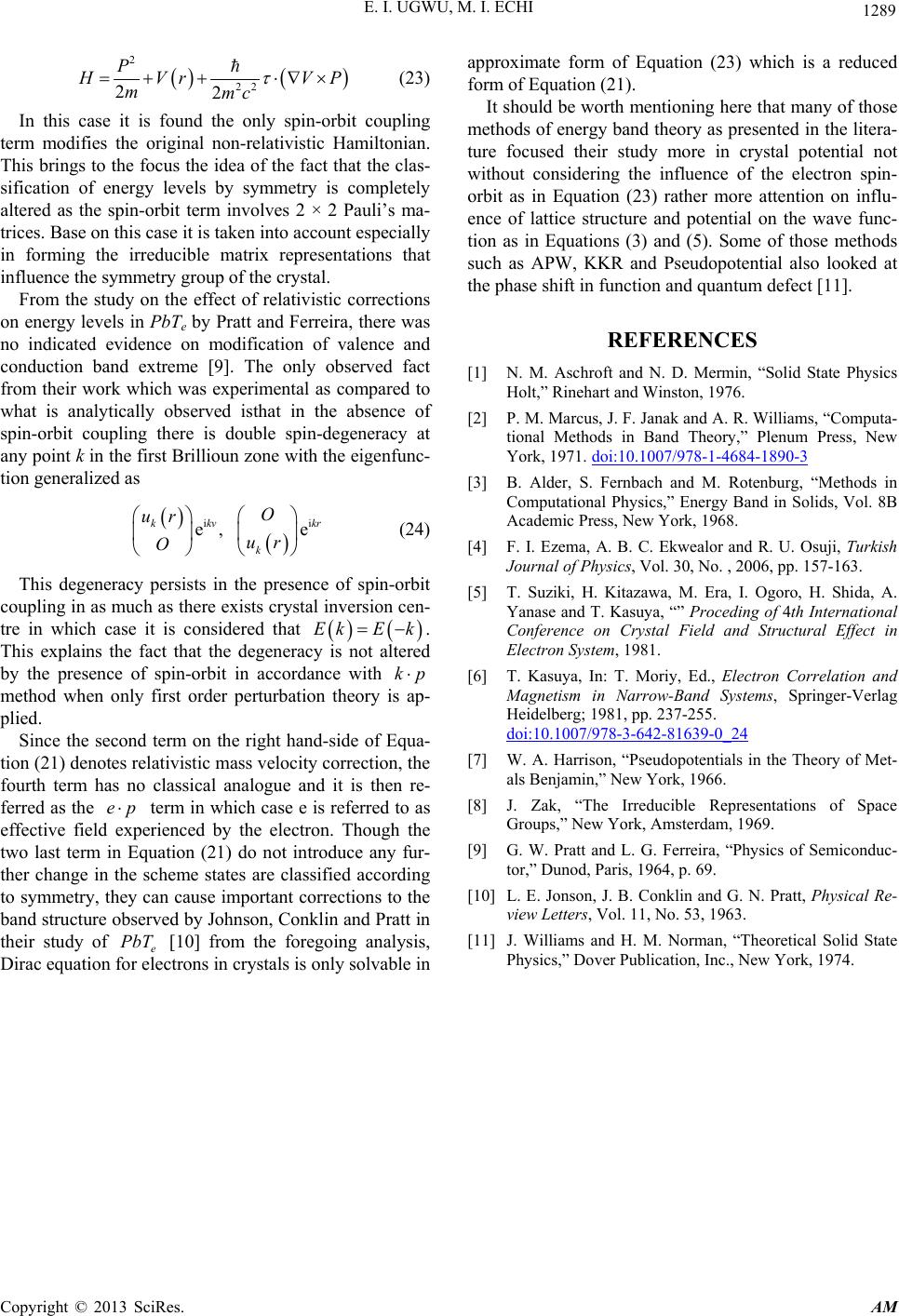
E. I. UGWU, M. I. ECHI
Copyright © 2013 SciRes. AM
1289
2
22
22
P
VrV P
mmc
(23)
In this case it is found the only spin-orb
term modifies the original non-relativistic Ham
Th
it coupling
iltonian.
is brings to the focus the idea of the fact that the clas-
sification of energy levels by symmetry is completely
altered as the spin-orbit term involves 2 × 2 Pauli’s ma-
trices. Base on this case it is taken into account especially
in forming the irreducible matrix representations that
influence the symmetry group of the crystal.
From the study on the effect of relativistic corrections
on energy levels in PbTe by Pratt and Ferreira, there was
no indicated evidence on modification of valence and
conduction band extreme [9]. The only observed fact
from their work which was experimental as compared to
what is analytically observed isthat in the absence of
spin-orbit coupling there is double spin-degeneracy at
any point k in the first Brillioun zone with the eigenfunc-
tion generalized as
O
ur
ii
e, e
kv kr
k
k
ur
O
(24)
This degeneracy persists in the presenc
coupling in as much as there exists crystal inversion cen-
tre
e of spin-orbit
in which case it is considered that
EkE k
.
This explains the fact that the degeneracy is not altered
by the presence of spin-orbit in accordance with kp
method when only first order perturbation theory is ap-
plied.
Since the second term on the right hand-side of Equa-
tion (21) denotes relativistic mass velocity correction, the
fourth term has no classical analogue and it is then re-
ferred as the ep term in which case e is referred to as
effective field experienced by the electron. Though the
two last term quation (21) do not introduce any fur-
ther change in the scheme states are classified according
to symmetry, they can cause important corrections to the
band structure observed by Johnson, Conklin and Pratt in
their study of e
PbT [10] from the foregoing analysis,
Dirac equation for electrons in crystals is only solvable in
approximate form of Equation (23) which is a reduced
form of Equation (21).
It should be worth m
in E
entioning here that many of those
m
REFERENCES
[1] N. M. Aschroolid State Physics
illiams, “Computa-
ethods of energy band theory as presented in the litera-
ture focused their study more in crystal potential not
without considering the influence of the electron spin-
orbit as in Equation (23) rather more attention on influ-
ence of lattice structure and potential on the wave func-
tion as in Equations (3) and (5). Some of those methods
such as APW, KKR and Pseudopotential also looked at
the phase shift in function and quantum defect [11].
ft and N. D. Mermin, “S
Holt,” Rinehart and Winston, 1976.
[2] P. M. Marcus, J. F. Janak and A. R. W
tional Methods in Band Theory,” Plenum Press, New
York, 1971. doi:10.1007/978-1-4684-1890-3
[3] B. Alder, S. Fernbach and M. Rotenburg, “Methods in
R. U. Osuji, Turkish
, A.
y, Ed., Electron Correlation and
4
Computational Physics,” Energy Band in Solids, Vol. 8B
Academic Press, New York, 1968.
[4] F. I. Ezema, A. B. C. Ekwealor and
Journal of Physics, Vol. 30, No. , 2006, pp. 157-163.
[5] T. Suziki, H. Kitazawa, M. Era, I. Ogoro, H. Shida
Yanase and T. Kasuya, “” Proceding of 4th International
Conference on Crystal Field and Structural Effect in
Electron System, 1981.
[6] T. Kasuya, In: T. Mori
Magnetism in Narrow-Band Systems, Springer-Verlag
Heidelberg; 1981, pp. 237-255.
doi:10.1007/978-3-642-81639-0_2
the Theory of Met-
resentations of Space
of Semiconduc-
G. N. Pratt, Physical Re-
cal Solid State
[7] W. A. Harrison, “Pseudopotentials in
als Benjamin,” New York, 1966.
[8] J. Zak, “The Irreducible Rep
Groups,” New York, Amsterdam, 1969.
[9] G. W. Pratt and L. G. Ferreira, “Physics
tor,” Dunod, Paris, 1964, p. 69.
[10] L. E. Jonson, J. B. Conklin and
view Letters, Vol. 11, No. 53, 1963.
[11] J. Williams and H. M. Norman, “Theoreti
Physics,” Dover Publication, Inc., New York, 1974.